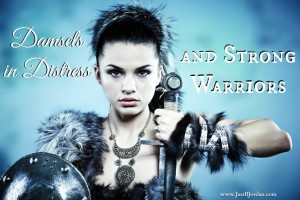Damsels in Distress and Strong Warriors: Stereotyped Female Characters
Two stereotypes rule female characters in fiction. The Damsel in Distress and the Strong Warrior.
The Damsel in Distress was used as a common heroine. She was in numerous fairy tales. Then our culture shifted, and we began to see her as a doormat. She was weak. She needed someone to save her. She didn’t know how to stand up for herself. We no longer saw her as a person, but as a doll.
So we threw her away.
We made a new, improved image of a woman. A Strong Warrior. We believed she was better than the Damsel in Distress. She didn’t sit around waiting to be saved. She fought. She knew her rights and defended them. She wasn’t weak, she was strong.
Now the Damsel in Distress is shunned and degraded in the stories she manages to find a place in. We don’t want her. We don’t need her. We have the Strong Warrior.
 …But we took her too far.
…But we took her too far.
With low or crop-cut clothing, guns or swords at her hip, and an icy personality, nothing will stand in the Strong Warriors way. She is a rebel and a loner. And she is everywhere. You often see her on the cover of a YA novel. In a TV show. In a movie.
The Strong Warrior is added into the cast of—usually all male—characters, her only purpose to be aloof, moody, violent, strong. The female representative.
In this setup each character has their own unique personality. They can be cowardly and arrogant. A kind, creative genius. A loyal peacemaker. Inquisitive and intelligent. Stubborn and narcissistic. Then we have the female of the group; she is strong.
She has become a stereotype.
A stereotype that can be as damaging as the Damsel in Distress. We used to tell girls that they needed to let themselves be saved. That they had to be timid. To do what they’re told and smile. Now we are telling them to be cold, be aloof, toughen up, don’t care. The more you lash out, with your words and with your actions, the stronger woman you are.
It seems as a culture, we no longer understand that:
Kindness doesn’t equal weakness, and violence doesn’t equal strength.
You can have a character who is kind but doesn’t allow people to manipulate her or walk over her rights as a human being. You can have a character who is strong, but can’t complete a roundhouse kick or swing a sword for fifteen minutes straight. Characters are supposed to be people, and people are multi-faceted. No one fits into a cookie cutter or a box.
Damsels in Distress and Strong Warriors have their place.
Don’t throw them away. They do exist. But when you’re putting them in a story, make them real. Give them a multi-layered personality.
And remember…
There are different forms of strength.
Integrity.
Perseverance.
Leadership.
Humility.
Prudence.
Humanity.
Boldness.
Self-control.
Humor.
Curiosity.
Ambition.
Wisdom.
Courage.
Loyalty.
Honor.
Patience.
Determination.
Hope.
Justice.
Honesty.
Self-respect.
People have layered strengths.
They don’t just have one. And everyone has their faults—numerous faults and weaknesses. This is how you take your Damsels in Distress and Strong Warriors and turn them into living, breathing people. They may have their toe in a cookie cutter, in a box—we all do—but it’s not the sole thing that defines them.
So, how do you go about writing a female character? Create a multi-faceted personality with hopes, fears, weaknesses, and strengths…and make them female.
Female or male, we’re all human.
It’s as simple as that.
Just B. Jordan is an award-winning author of fantasy and sci-fi. She graduated high school a year early and received her first publishing contract at the age of 18. To Ashes We Run is her most recent novel. Find it here.

Rosalie Valentine
O.O Wow, Jordan.
This post is brilliant; I appreciate it on so many levels. Thank you for writing this!
Deanna Fugett
This post is perfection. Excellent points!